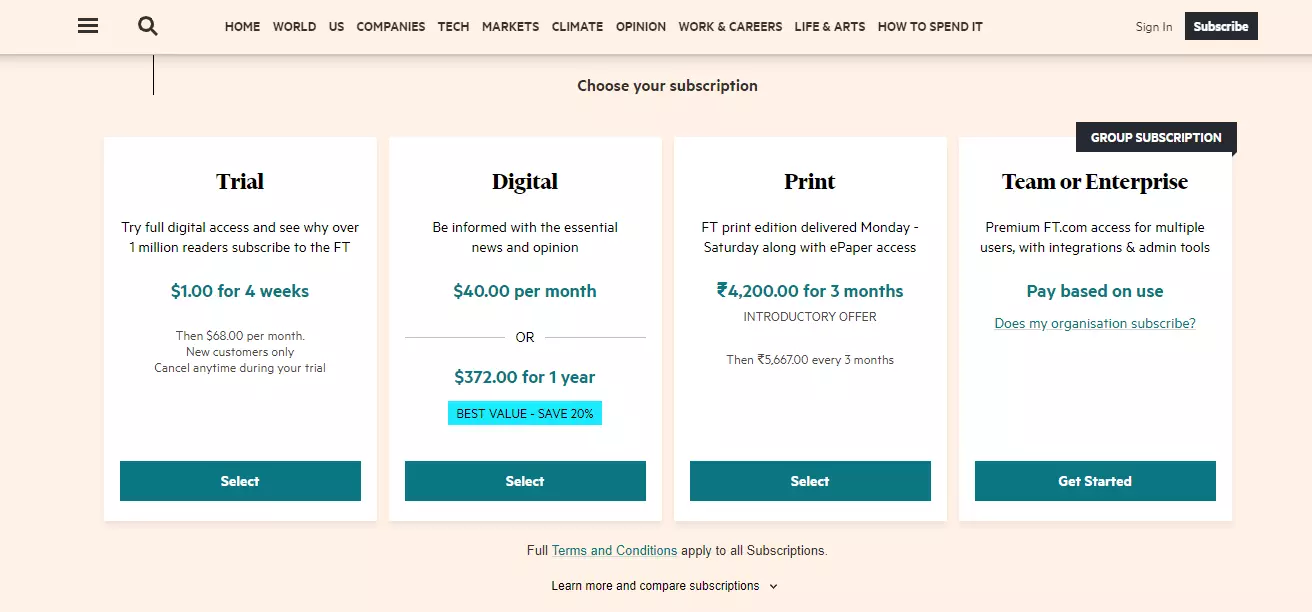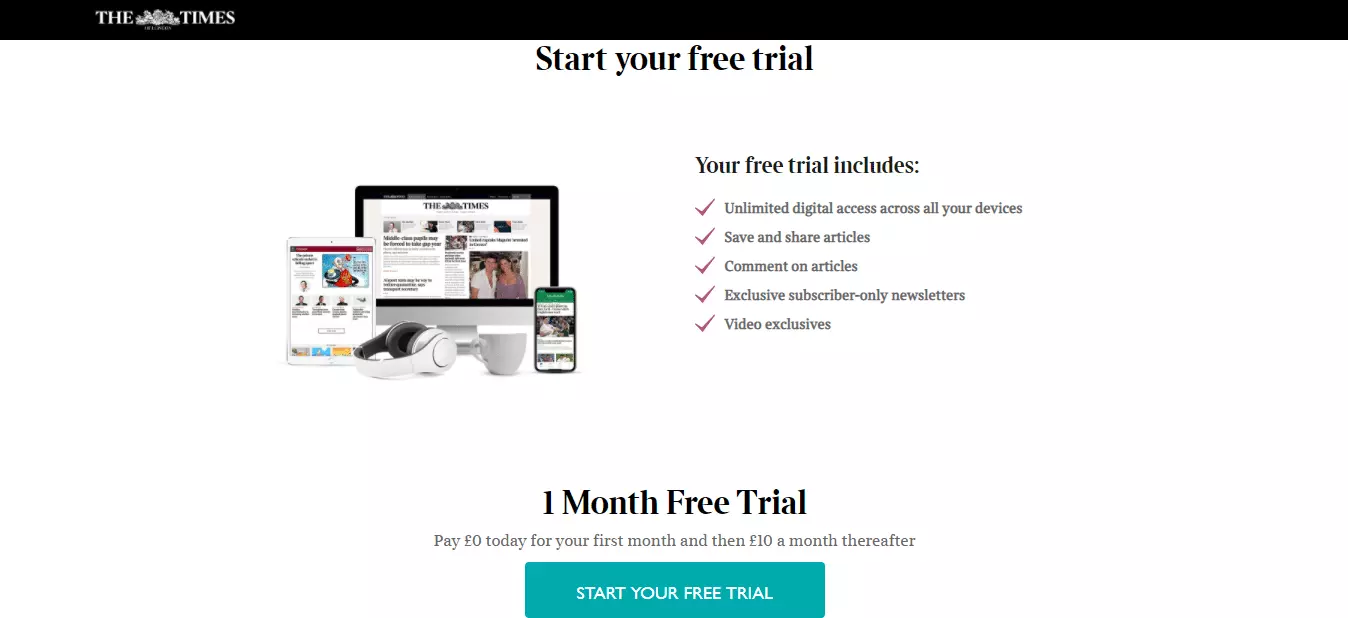Have you tried to convert your traffic into revenue by implementing a paywall? The idea of monetizing your content is not new. In fact, paywalls have been around for a while. But what types of paywalls are the best? Can you have a paywall and generate revenue without losing your audience? Or is it just meant for legacy media organizations?
In this article, we’ll have a rundown of different paywalls and how top publishers like The New York Times, The Wall Street Journal, and The Financial Times are leveraging paywalls to maximize their chances of converting readers into paying customers while also keeping those visitors coming back.
Types of Paywalls
As a publisher, you have to consider several factors when deciding the model for your next paywall. These include reader behavior, user experience, and business strategy—and the results can make a huge impact on your success. By knowing which type of paywall system is best for your business, you will better understand what drives subscribers to engage with your website.
So, before we talk about publishers’ paywall models, let’s first define the types of paywalls that exist:
- Hard Paywall
- Metered Paywall
- Freemium Paywall
- Dynamic Paywall
You can learn more about the types of paywalls in this article.
4 Paywall Models And Strategies of Top Publishers
1. Inside The Financial Times’ Data-driven Paywall Strategy
The Financial Times has one of the most impressive paywall success stories. It was one of the first publications to embrace a paywall and hasn’t looked back since. Many publishers were initially criticizing the idea of a paywall thinking it would limit reader reach, but the Financial Times has proven them wrong. Today, it has over 1 million paid subscribers — half of which are digital subscribers and over 75% of FT’s revenue comes from digital subscriptions
Type of Paywall: Hard Paywall. The Financial Times has been offering 4 different subscription plans:

What’s the key to FT’s paywall strategy?
The publisher has executed various data-driven strategies to deliver the right experience for the readers by analyzing the right engagement metrics. For example, the FT team introduced a new metric known as Quality Reads in the analytics to measure the percentage of PVs where the reader has read at least 50% of the article.
Additionally, the publisher measures the frequency of visitors reading a particular content, the number of articles read per visit, and more. With this information, the FT has uncovered the goals of its readers and delivered the content that resonated with them. There are many strategies that can be attached to the FT’s success – from building communities via newsletters to changing the focus to readership demographics. Our case study on the Financial Times’ growth strategies will help you learn more.
2. Understanding The Wall Street Journal’s paywall
The Wall Street Journal paywall strategy is indeed a smart one. When the publisher launched the paywall in 1997, it offered a freemium model where it only put selected content behind the paywall. But when the publisher hit 3 million subscribers, the newsroom took this to a whole new level, putting all of their news content behind a paywall.
Types of Paywall: Hard Paywall and Dynamic Paywall
As of the publisher’s paywall model today, The Wall Street Journal has been offering 2 different subscription plans:

What’s the key to the WSJ’s paywall strategy?
A statistical approach in an effort to serve its readers better. The Wall Street Journal has implemented various multifaceted strategies that not only use first-party data but also user engagement testing. One of such strategies offers a “24-hour free pass” to the non-subscribers in exchange for their email addresses.
Further, the publisher combines the first-party audience with machine learning algorithms to build a dynamic paywall for readers. In plain English, The Journal’s newsroom analyzes the propensity score of the readers based on visit frequency, preferred content type, devices they’re on, and more.
“We are a dynamic paywall, we can flex based on the audience but as far as the consumer sees, we are a freemium paywall.”
– Karl Wells, General Manager of Subscription Sales, The Journal (Src)
For years, the Wall Street Journal has been making waves in the publishing industry by successfully modeling subscription strategies around convenience and access. So how did they get it so right? Discover intriguing facts about their paywall strategies in detail here.
3. Behind the success of The New York Times’ Paywall strategy
The New York Times hit 5 million subscribers in Q1, 2020, and gets more revenue from digital subscribers than print advertising revenue. The publisher managed to put in place a system that justified its subscription fees while also being found to be one of the most effective paywalls out there.
Type of Paywall: Dynamic paywall
Unlike the Financial Times and The Wall Street Journal, The New York Times offers one subscription plan for all readers. However, as the paywall is dynamic, readers are exposed to it based on their reading frequency and page sessions.

What’s the key to NYT’s paywall strategy?
Testing and iterating the strategies through qualitative feedback and creating a user retention-centric model. Unlike other publications, the publisher has a team of 10 people that primarily focuses on new subscribers and their behavior for the first 90 days. The team sends emails about The NYTimes’ coverage and news products. Another strategy involves identifying users that are about to drop the subscription.
The publisher leverages the retention model to detect when the subscribers visit the website less often. That informs the newsroom to reiterate the model in order to re-engage the readers such as promoting the articles on readers’ Facebook feeds via interactive stories.
“The more people read those, the more likely they are to subscribe. It really helps people understand the value of the Times. It does the persuasion for us.”
– Clay Fisher, SVP of Consumer Revenue, The NYTimes (Src)
The Grey Lady is famous for its digital stories and publishes 300+ news articles daily and millions of readers are hooked to its articles. The digital subscriber growth has been attributed to its efforts in increasing audience engagement and getting new people to subscribe. publisher optimizes the content strategy, channels, and tactics that resonate with its target audience. What else the NYTimes do differently to generate revenue? Read more about it in detail here.
4. How The Times UK’s paywall pays off
In 2010, when The Times introduced a paywall for the first time, John Witherow, Editor of The Sunday Times, admitted the step was a “big gamble”. And did you know lost 4 million readers to its paywall experiment? In a bid to fight falling circulation, and find the alternatives to lose in ad revenue, The Times UK tested a few subscription strategies over the last decade.

Today, The Times has over 350k+ digital subscribers, and it accounts for more than 56% to total subscriptions.
Type of Paywalls: Metered and Hard Paywall

What’s the key to Time’s paywall strategy?
A strategy that revolves around four factors: number of articles read, frequency of visiting the website, interaction with the services, and the last time when the service was used. Also, The Times is using artificial intelligence to serve personalized content to the audience and reduce the churn rate.
Another important factor that contributes to The Times UK’s success is encouraging the journalists to interact with readers. A team of 5 people prioritizes the types of articles on which they should focus. The team analyzed that subscribers who engage with comments engage more with the articles.
“We model that engagement out, which has a direct correlation to retention rates, so we think ‘How do we drive each of these? Can we increase options to read, or signpost tomorrow’s edition, or embed habit?”
– Chris Duncan, Managing Director, The Times (Src)
The Times UK has had a hard paywall since 2010, and it understands the need to loosen the paywall or make it hard for the readers. Find out how The Times UK grew its subscriber base here.
What’s Next?
There is a lot to talk about successful and unsuccessful paywall strategies. Many of them fail, while others succeed. If you want to do it right, you can’t just take a snapshot of how other organizations have done things and expect it to just work in your case. You’ve got to do your own research, execute the strategies based on your resources, and then you can make an informed decision.
Found it useful and looking for more insights on top publishers’ growth strategies and what works? Learn from the publishers that drive over tens of million impressions daily, and start using best practices for subscriptions, ads, products, and more. Click here to learn more.























